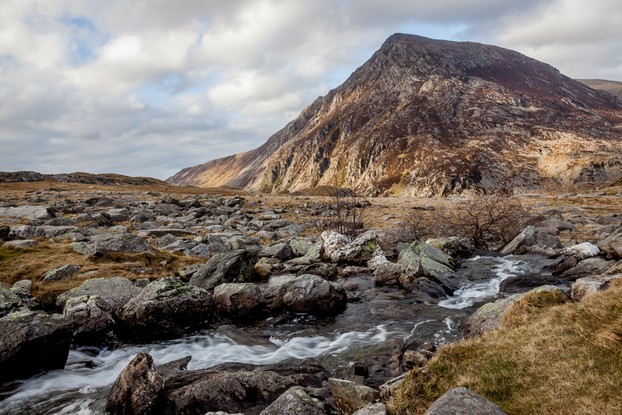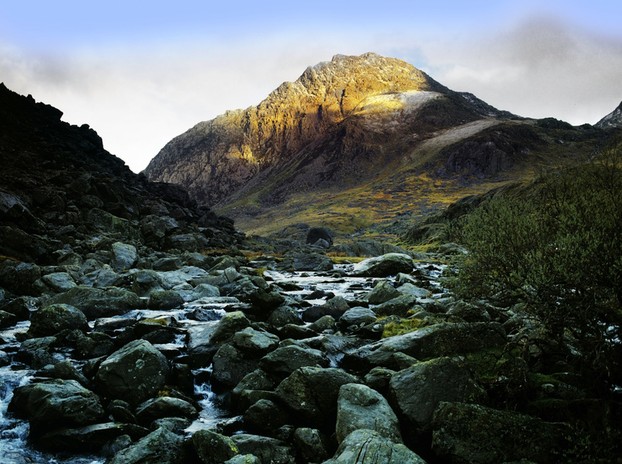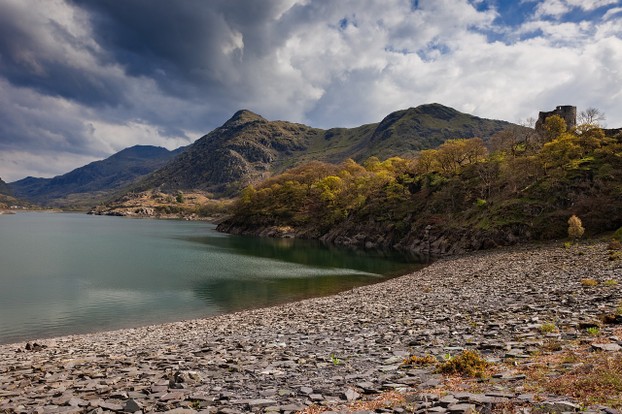I tackled the first part of the route, the Carneddau Ridge, in high summer, and that was not the best of times, as the ridge is short of water and so all water must be carried, therefore do the route on a good cool Spring day and travel light, taking a bivouac, enough food and plenty of water. I would advise getting a good evening meal and then starting high up, so ascend from Aber [on the North Wales coast] and camp overnight in the hills so as to get a good start. People do camp wild on the ridge.
The first hill is Drum, a ridge of about 2500 feet with a stone shelter on top,which is where some people camp, but generally the best feature of Drum is the views, which to the south reach over the Menai Straits towards Anglesey and eastwards to the Conwy valley. But there is to be no lingering on such a journey, so you descend the col to begin the steep, grassy ascent to the next summit, Foel Fras the first of your Munros. I recall once pausing to brew some tea on the slopes,but the wind played havoc with my flame, so I contented myself with a cold drink.
From then it is a short hop to Carnedd Uchaf, now renamed as Carnned Gwenllian after the daughter of the great Welsh prince Llewelyn. This is a pleasant summit that involves little descent and ascent from Foel Gras. Next comes the higher summit, Foel Grach, which is a straightforward ascent on, but from it you can see the bulk of Carnedd Llewelyn, Wales' second highest mountain at over 3400 feet, swelling to the south of you. This part of the ridge is rockier than the early bits are and Carnedd Llewelyn is an impressive summit. The view to the north reaches over the Carneddau moorlands, to the east the rolling moors of Denbighshire in the distance, and to the south and west Snowdonia and its mountains. The summit of Snowdon itself peeps tantalisingly over the next range reminding you of your goal.
The outlier on the ridge is Yr Elen, which can be reached by a detour from Carnedd Llewelyn, but on my six hour walk along the ridge the condition of my companion, who had given me cause for concern, led me to abandon that detour in order to descend as soon as possible. I had trusted his fitness, but I did not know that he had spent the previous night drinking and was dehydrated as a result. And on a scorching summer's day as well! As we were slower than I had expected because of this problem, we had run out of water too early, and that made the last lap difficult.
Carnedd Llewelyn leads on to Carnedd Dafyd, named after Wales' patron saint and then by a short [only six feet long, but very narrow] ridge you gain access to Pen yr Oleu Wen, the final peak on this stage, which at 3211 feet is one foot higher than any English mountain. The steep path down winds among rocks, but we found a very welcome spring of clear fresh water, which gave us both a boost about half way down.
For most of the year a kiosk, known as the Tea Shack, is open at the point where you reach the road. This is an ideal place to get drinks and a burger, and you can fill your your water bottles in the stream that gushes out of Llyn Ogwen ahead of the next stage in the ascent.













 TheThousand Year Gardenon 11/26/2025
TheThousand Year Gardenon 11/26/2025
 Women of the Gospelson 10/11/2025
Women of the Gospelson 10/11/2025
 Religious Gardenson 08/25/2025
Religious Gardenson 08/25/2025
 Doctor of the Church: John Henry Newmanon 08/03/2025
Doctor of the Church: John Henry Newmanon 08/03/2025



Comments
The legends say that the dogs used to congregate at the lake when the Welsh chiefs were hunting. There is no tradition of dogs being buried there.
Thank you for your comment below, in answer to my previous observation and question.
Might the Lake of Dogs memorialize the hunting dogs generally or specifically as where perhaps it most mattered to them to hunt or to live or to rest eternally in grave sites around the waters or on the lake bottom?
Welsh chiefs used these dogs as hounds for hunting.
The second paragraph to the second subheading, Steep, short and sharp, advises us that "The route takes you over the boulder-strewn summits of Glydr Fach past a lake known as Llyn Cwn, the Lake of Dogs."
Is there an extant explanation what dogs of whom, when, where, why inspired that afore-indicated place name?
Your comment Oct. 29, 2019, in answer to my previous question Oct. 28, 2019, indicates some familiarity with modern Welsh.
Is that familiarity describable as basic comprehension, reading, speaking and writing skills?
(Might you have an English -- ;-D -- accent in your spoken Welsh?)
Thanks Derdriu. I am attempting to raise my walking speed. Maybe by spring or summer I will be ready again.
frankbeswick, May your exercises work as well on your balance and speed as medical treatments did on your posture!
You must realize that Welsh has several dialects, and so Foel Fras is in the North Wales dialect. It means broad hill. Moel means a hill, but Celtic languages mutate, so in certain circumstances M mutates to F, giving us Foel. My Welsh is not good enough to explain any more than this.
The wind was not strong enough to knock me over on that occasion, but on another it was sufficiently strong to knock my friend Cahal over. He is lighter weight than I am. I was merely spun round by it, as it caught my haversack.That was at 2500 feet.
I am sad to say that while medical treatment has recovered my posture, my balance is still not right and my speed has not recovered, so a walk of this character is not now a possibility. But I am still hopeful and doing the exercises!
frankbeswick, Thank you for the photos, practicalities and products.
What does Foel Fras mean? The google translator gives "bare foal"!
Is the wind that "played havoc" with your tea break ever strong enough to knock someone over?
Saxons had been coming in for many a year before Vortigern, as garrison troops,so Vortigern only perpetuated a Roman policy. Moreover, Vortigern invited the Jutes, who settled in Kent. The reason for introducing Saxons, Angles and Jutes was to hold back the Picts, who were ruthlessly raiding, plundering and slaving deep into Britain. Without the Saxons the Picts would probably have dominated and plundered much of the isle.